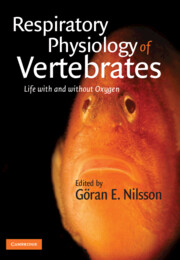Book contents
- Frontmatter
- Contents
- List of contributors
- Preface
- Abbreviations
- Part I General principles
- Part II Special cases
- 5 Adaptations to hypoxia in fishes
- 6 Breathing air in water and in air: the air-breathing fishes
- 7 Air breathers under water: diving mammals and birds
- 8 Vertebrate life at high altitude
- 9 Surviving without any oxygen
- Index
- References
7 - Air breathers under water: diving mammals and birds
Published online by Cambridge University Press: 05 June 2012
- Frontmatter
- Contents
- List of contributors
- Preface
- Abbreviations
- Part I General principles
- Part II Special cases
- 5 Adaptations to hypoxia in fishes
- 6 Breathing air in water and in air: the air-breathing fishes
- 7 Air breathers under water: diving mammals and birds
- 8 Vertebrate life at high altitude
- 9 Surviving without any oxygen
- Index
- References
Summary
Introduction
Most people know that seals spend most of their time, and whales all of their time, in water, but research over the last few decades has shown that several species of both orders of these air-breathing mammals spend as much as 80–90% of the time under water. Moreover, sperm whales (Physeter catodon) (Watkins et al., 1985) and southern elephant seals (Mirounga leonina) (Hindell et al., 1992) normally dive to 300–600 m, but may dive to more than 1000 m and occasionally remain submerged for a staggering 2 hours. Hooded seals (Cystophora cristata) normally also dive to 300–600 m with dive durations of 5–25 minutes, but some individuals specialize in repetitive deep diving to more than 1000 m, with durations of up to one hour (Folkow and Blix, 1999). Even birds such as the emperor penguin (Aptenodytes forsteri) dive to depths of 550 m with durations of more than 15 minutes (Kooyman and Kooyman, 1995). How is this achieved? Let us look at what physiological problems life under water imposes on air-breathing animals such as whales, seals, penguins, and ducks – but before we do, we have to define ‘diving,’ for reasons that will be obvious as we go along. Thus, in the following, ‘experimental dive’ implies that the animal is held under water more or less against its own will, whereas ‘voluntary dive’ implies that an animal swimming freely (in a pond or in the ocean) dives of its own free will.
- Type
- Chapter
- Information
- Respiratory Physiology of VertebratesLife With and Without Oxygen, pp. 222 - 264Publisher: Cambridge University PressPrint publication year: 2010
References
- 5
- Cited by



